EDU203: Literacy, Numeracy, Competence, and Daily Significance
VerifiedAdded on 2023/04/25
|8
|2368
|488
Essay
AI Summary
This essay provides a comprehensive overview of literacy and numeracy, highlighting their significance in daily life from both functional and socio-cultural perspectives. It delves into the definitions of literacy and numeracy, emphasizing their roles in communication, problem-solving, and adaptation to a globalized world. The essay explores the impact of varying levels of literacy and numeracy competence on individuals' functional lives, educational experiences, and work prospects. Furthermore, it addresses the potential causes of differences in the development of these skills, considering both individual and group-level factors. The discussion incorporates relevant theories and references to support its arguments, ultimately concluding that both literacy and numeracy are equally vital for personal, educational, and professional success in the modern world. Desklib offers a wealth of similar academic resources for students.
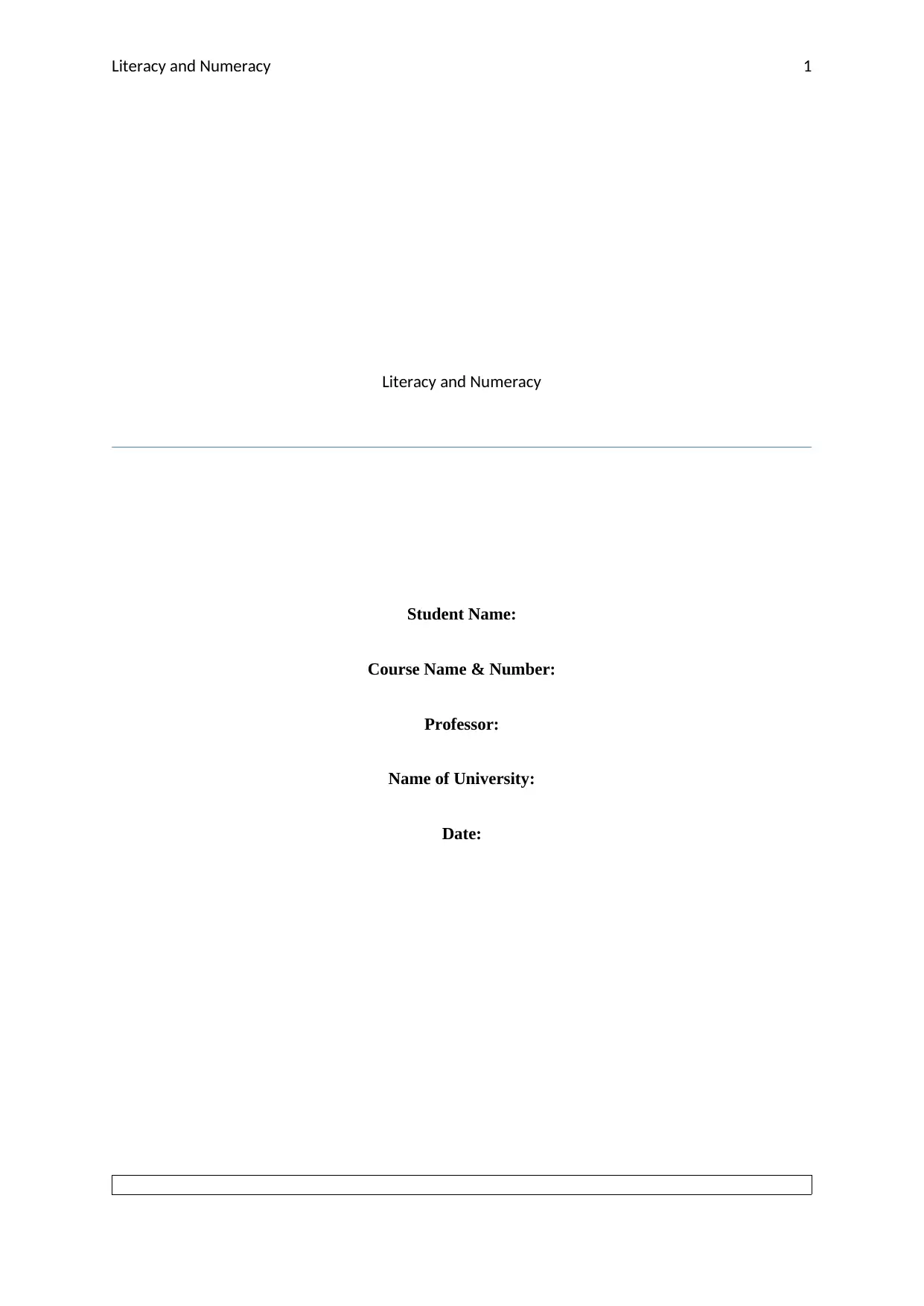
Literacy and Numeracy 1
Literacy and Numeracy
Student Name:
Course Name & Number:
Professor:
Name of University:
Date:
Literacy and Numeracy
Student Name:
Course Name & Number:
Professor:
Name of University:
Date:
Paraphrase This Document
Need a fresh take? Get an instant paraphrase of this document with our AI Paraphraser
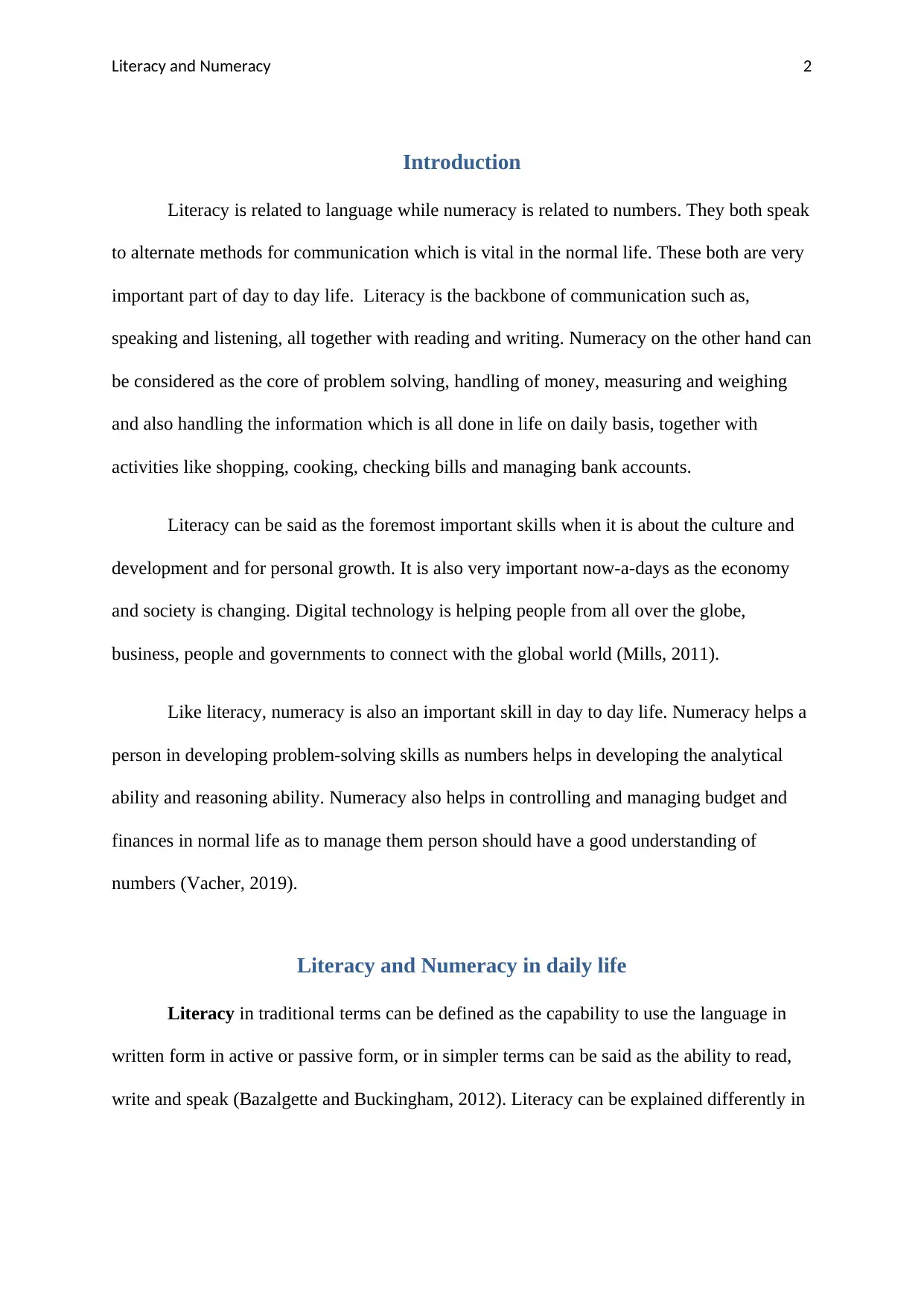
Literacy and Numeracy 2
Introduction
Literacy is related to language while numeracy is related to numbers. They both speak
to alternate methods for communication which is vital in the normal life. These both are very
important part of day to day life. Literacy is the backbone of communication such as,
speaking and listening, all together with reading and writing. Numeracy on the other hand can
be considered as the core of problem solving, handling of money, measuring and weighing
and also handling the information which is all done in life on daily basis, together with
activities like shopping, cooking, checking bills and managing bank accounts.
Literacy can be said as the foremost important skills when it is about the culture and
development and for personal growth. It is also very important now-a-days as the economy
and society is changing. Digital technology is helping people from all over the globe,
business, people and governments to connect with the global world (Mills, 2011).
Like literacy, numeracy is also an important skill in day to day life. Numeracy helps a
person in developing problem-solving skills as numbers helps in developing the analytical
ability and reasoning ability. Numeracy also helps in controlling and managing budget and
finances in normal life as to manage them person should have a good understanding of
numbers (Vacher, 2019).
Literacy and Numeracy in daily life
Literacy in traditional terms can be defined as the capability to use the language in
written form in active or passive form, or in simpler terms can be said as the ability to read,
write and speak (Bazalgette and Buckingham, 2012). Literacy can be explained differently in
Introduction
Literacy is related to language while numeracy is related to numbers. They both speak
to alternate methods for communication which is vital in the normal life. These both are very
important part of day to day life. Literacy is the backbone of communication such as,
speaking and listening, all together with reading and writing. Numeracy on the other hand can
be considered as the core of problem solving, handling of money, measuring and weighing
and also handling the information which is all done in life on daily basis, together with
activities like shopping, cooking, checking bills and managing bank accounts.
Literacy can be said as the foremost important skills when it is about the culture and
development and for personal growth. It is also very important now-a-days as the economy
and society is changing. Digital technology is helping people from all over the globe,
business, people and governments to connect with the global world (Mills, 2011).
Like literacy, numeracy is also an important skill in day to day life. Numeracy helps a
person in developing problem-solving skills as numbers helps in developing the analytical
ability and reasoning ability. Numeracy also helps in controlling and managing budget and
finances in normal life as to manage them person should have a good understanding of
numbers (Vacher, 2019).
Literacy and Numeracy in daily life
Literacy in traditional terms can be defined as the capability to use the language in
written form in active or passive form, or in simpler terms can be said as the ability to read,
write and speak (Bazalgette and Buckingham, 2012). Literacy can be explained differently in
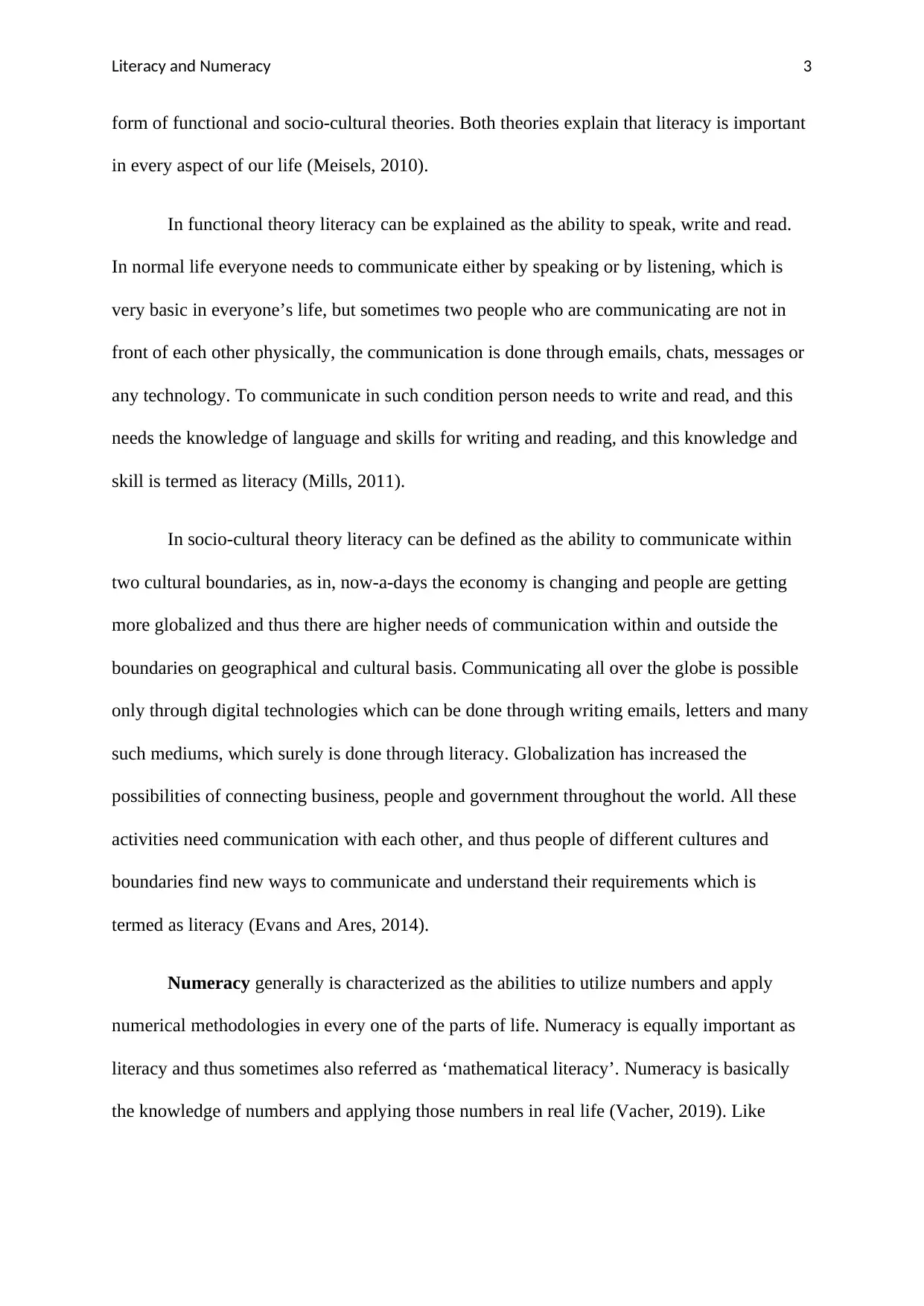
Literacy and Numeracy 3
form of functional and socio-cultural theories. Both theories explain that literacy is important
in every aspect of our life (Meisels, 2010).
In functional theory literacy can be explained as the ability to speak, write and read.
In normal life everyone needs to communicate either by speaking or by listening, which is
very basic in everyone’s life, but sometimes two people who are communicating are not in
front of each other physically, the communication is done through emails, chats, messages or
any technology. To communicate in such condition person needs to write and read, and this
needs the knowledge of language and skills for writing and reading, and this knowledge and
skill is termed as literacy (Mills, 2011).
In socio-cultural theory literacy can be defined as the ability to communicate within
two cultural boundaries, as in, now-a-days the economy is changing and people are getting
more globalized and thus there are higher needs of communication within and outside the
boundaries on geographical and cultural basis. Communicating all over the globe is possible
only through digital technologies which can be done through writing emails, letters and many
such mediums, which surely is done through literacy. Globalization has increased the
possibilities of connecting business, people and government throughout the world. All these
activities need communication with each other, and thus people of different cultures and
boundaries find new ways to communicate and understand their requirements which is
termed as literacy (Evans and Ares, 2014).
Numeracy generally is characterized as the abilities to utilize numbers and apply
numerical methodologies in every one of the parts of life. Numeracy is equally important as
literacy and thus sometimes also referred as ‘mathematical literacy’. Numeracy is basically
the knowledge of numbers and applying those numbers in real life (Vacher, 2019). Like
form of functional and socio-cultural theories. Both theories explain that literacy is important
in every aspect of our life (Meisels, 2010).
In functional theory literacy can be explained as the ability to speak, write and read.
In normal life everyone needs to communicate either by speaking or by listening, which is
very basic in everyone’s life, but sometimes two people who are communicating are not in
front of each other physically, the communication is done through emails, chats, messages or
any technology. To communicate in such condition person needs to write and read, and this
needs the knowledge of language and skills for writing and reading, and this knowledge and
skill is termed as literacy (Mills, 2011).
In socio-cultural theory literacy can be defined as the ability to communicate within
two cultural boundaries, as in, now-a-days the economy is changing and people are getting
more globalized and thus there are higher needs of communication within and outside the
boundaries on geographical and cultural basis. Communicating all over the globe is possible
only through digital technologies which can be done through writing emails, letters and many
such mediums, which surely is done through literacy. Globalization has increased the
possibilities of connecting business, people and government throughout the world. All these
activities need communication with each other, and thus people of different cultures and
boundaries find new ways to communicate and understand their requirements which is
termed as literacy (Evans and Ares, 2014).
Numeracy generally is characterized as the abilities to utilize numbers and apply
numerical methodologies in every one of the parts of life. Numeracy is equally important as
literacy and thus sometimes also referred as ‘mathematical literacy’. Numeracy is basically
the knowledge of numbers and applying those numbers in real life (Vacher, 2019). Like
⊘ This is a preview!⊘
Do you want full access?
Subscribe today to unlock all pages.

Trusted by 1+ million students worldwide
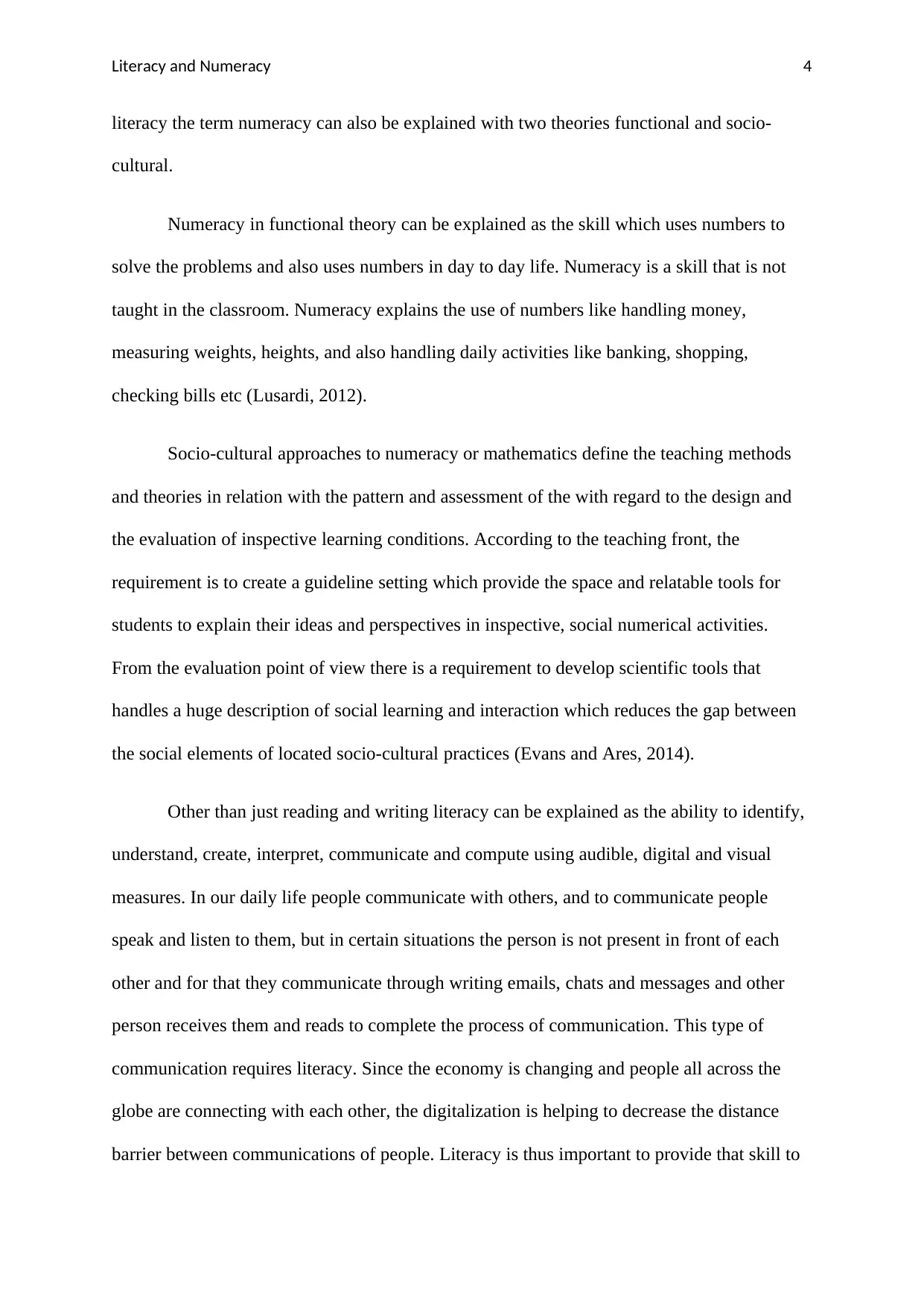
Literacy and Numeracy 4
literacy the term numeracy can also be explained with two theories functional and socio-
cultural.
Numeracy in functional theory can be explained as the skill which uses numbers to
solve the problems and also uses numbers in day to day life. Numeracy is a skill that is not
taught in the classroom. Numeracy explains the use of numbers like handling money,
measuring weights, heights, and also handling daily activities like banking, shopping,
checking bills etc (Lusardi, 2012).
Socio-cultural approaches to numeracy or mathematics define the teaching methods
and theories in relation with the pattern and assessment of the with regard to the design and
the evaluation of inspective learning conditions. According to the teaching front, the
requirement is to create a guideline setting which provide the space and relatable tools for
students to explain their ideas and perspectives in inspective, social numerical activities.
From the evaluation point of view there is a requirement to develop scientific tools that
handles a huge description of social learning and interaction which reduces the gap between
the social elements of located socio-cultural practices (Evans and Ares, 2014).
Other than just reading and writing literacy can be explained as the ability to identify,
understand, create, interpret, communicate and compute using audible, digital and visual
measures. In our daily life people communicate with others, and to communicate people
speak and listen to them, but in certain situations the person is not present in front of each
other and for that they communicate through writing emails, chats and messages and other
person receives them and reads to complete the process of communication. This type of
communication requires literacy. Since the economy is changing and people all across the
globe are connecting with each other, the digitalization is helping to decrease the distance
barrier between communications of people. Literacy is thus important to provide that skill to
literacy the term numeracy can also be explained with two theories functional and socio-
cultural.
Numeracy in functional theory can be explained as the skill which uses numbers to
solve the problems and also uses numbers in day to day life. Numeracy is a skill that is not
taught in the classroom. Numeracy explains the use of numbers like handling money,
measuring weights, heights, and also handling daily activities like banking, shopping,
checking bills etc (Lusardi, 2012).
Socio-cultural approaches to numeracy or mathematics define the teaching methods
and theories in relation with the pattern and assessment of the with regard to the design and
the evaluation of inspective learning conditions. According to the teaching front, the
requirement is to create a guideline setting which provide the space and relatable tools for
students to explain their ideas and perspectives in inspective, social numerical activities.
From the evaluation point of view there is a requirement to develop scientific tools that
handles a huge description of social learning and interaction which reduces the gap between
the social elements of located socio-cultural practices (Evans and Ares, 2014).
Other than just reading and writing literacy can be explained as the ability to identify,
understand, create, interpret, communicate and compute using audible, digital and visual
measures. In our daily life people communicate with others, and to communicate people
speak and listen to them, but in certain situations the person is not present in front of each
other and for that they communicate through writing emails, chats and messages and other
person receives them and reads to complete the process of communication. This type of
communication requires literacy. Since the economy is changing and people all across the
globe are connecting with each other, the digitalization is helping to decrease the distance
barrier between communications of people. Literacy is thus important to provide that skill to
Paraphrase This Document
Need a fresh take? Get an instant paraphrase of this document with our AI Paraphraser
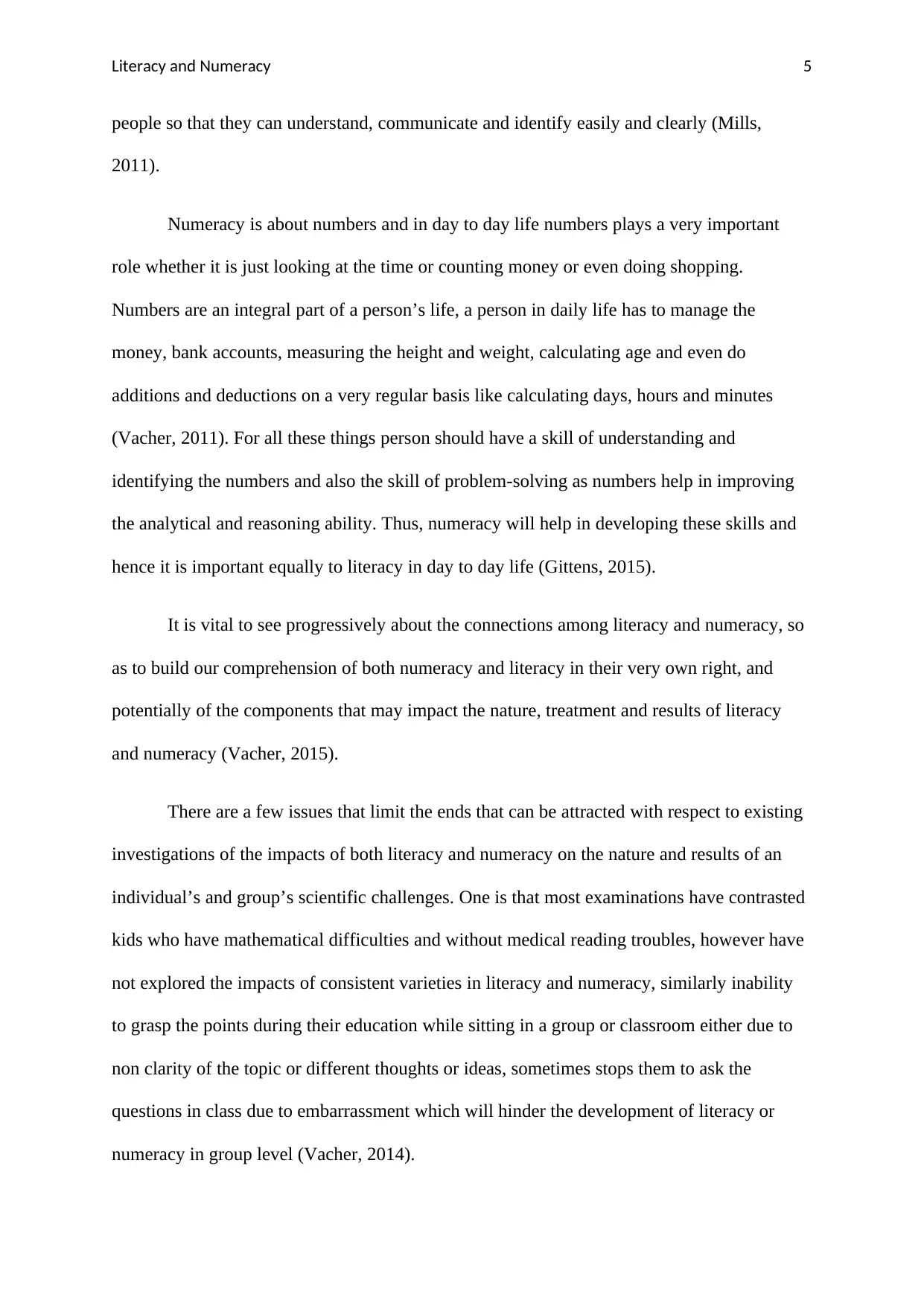
Literacy and Numeracy 5
people so that they can understand, communicate and identify easily and clearly (Mills,
2011).
Numeracy is about numbers and in day to day life numbers plays a very important
role whether it is just looking at the time or counting money or even doing shopping.
Numbers are an integral part of a person’s life, a person in daily life has to manage the
money, bank accounts, measuring the height and weight, calculating age and even do
additions and deductions on a very regular basis like calculating days, hours and minutes
(Vacher, 2011). For all these things person should have a skill of understanding and
identifying the numbers and also the skill of problem-solving as numbers help in improving
the analytical and reasoning ability. Thus, numeracy will help in developing these skills and
hence it is important equally to literacy in day to day life (Gittens, 2015).
It is vital to see progressively about the connections among literacy and numeracy, so
as to build our comprehension of both numeracy and literacy in their very own right, and
potentially of the components that may impact the nature, treatment and results of literacy
and numeracy (Vacher, 2015).
There are a few issues that limit the ends that can be attracted with respect to existing
investigations of the impacts of both literacy and numeracy on the nature and results of an
individual’s and group’s scientific challenges. One is that most examinations have contrasted
kids who have mathematical difficulties and without medical reading troubles, however have
not explored the impacts of consistent varieties in literacy and numeracy, similarly inability
to grasp the points during their education while sitting in a group or classroom either due to
non clarity of the topic or different thoughts or ideas, sometimes stops them to ask the
questions in class due to embarrassment which will hinder the development of literacy or
numeracy in group level (Vacher, 2014).
people so that they can understand, communicate and identify easily and clearly (Mills,
2011).
Numeracy is about numbers and in day to day life numbers plays a very important
role whether it is just looking at the time or counting money or even doing shopping.
Numbers are an integral part of a person’s life, a person in daily life has to manage the
money, bank accounts, measuring the height and weight, calculating age and even do
additions and deductions on a very regular basis like calculating days, hours and minutes
(Vacher, 2011). For all these things person should have a skill of understanding and
identifying the numbers and also the skill of problem-solving as numbers help in improving
the analytical and reasoning ability. Thus, numeracy will help in developing these skills and
hence it is important equally to literacy in day to day life (Gittens, 2015).
It is vital to see progressively about the connections among literacy and numeracy, so
as to build our comprehension of both numeracy and literacy in their very own right, and
potentially of the components that may impact the nature, treatment and results of literacy
and numeracy (Vacher, 2015).
There are a few issues that limit the ends that can be attracted with respect to existing
investigations of the impacts of both literacy and numeracy on the nature and results of an
individual’s and group’s scientific challenges. One is that most examinations have contrasted
kids who have mathematical difficulties and without medical reading troubles, however have
not explored the impacts of consistent varieties in literacy and numeracy, similarly inability
to grasp the points during their education while sitting in a group or classroom either due to
non clarity of the topic or different thoughts or ideas, sometimes stops them to ask the
questions in class due to embarrassment which will hinder the development of literacy or
numeracy in group level (Vacher, 2014).
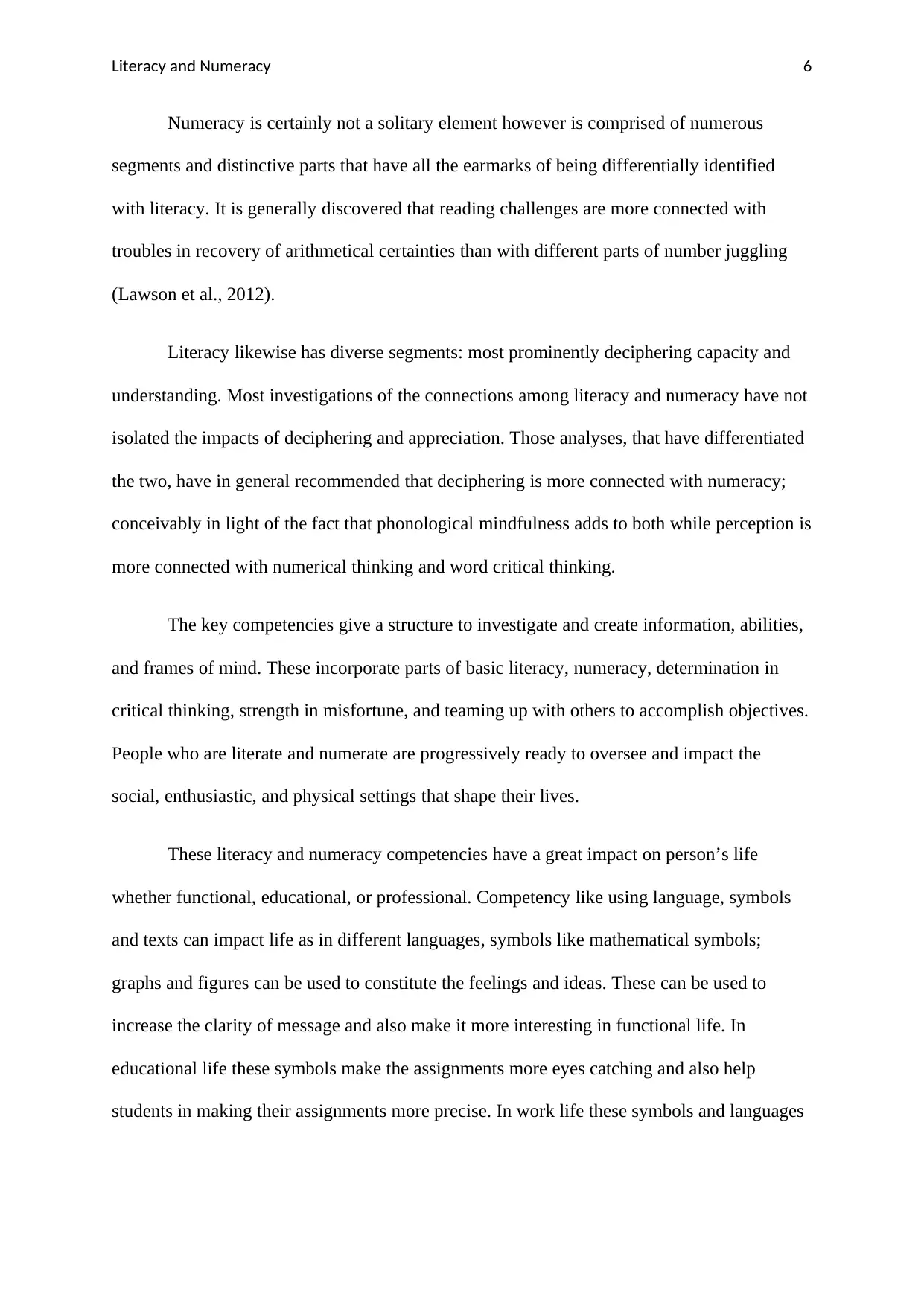
Literacy and Numeracy 6
Numeracy is certainly not a solitary element however is comprised of numerous
segments and distinctive parts that have all the earmarks of being differentially identified
with literacy. It is generally discovered that reading challenges are more connected with
troubles in recovery of arithmetical certainties than with different parts of number juggling
(Lawson et al., 2012).
Literacy likewise has diverse segments: most prominently deciphering capacity and
understanding. Most investigations of the connections among literacy and numeracy have not
isolated the impacts of deciphering and appreciation. Those analyses, that have differentiated
the two, have in general recommended that deciphering is more connected with numeracy;
conceivably in light of the fact that phonological mindfulness adds to both while perception is
more connected with numerical thinking and word critical thinking.
The key competencies give a structure to investigate and create information, abilities,
and frames of mind. These incorporate parts of basic literacy, numeracy, determination in
critical thinking, strength in misfortune, and teaming up with others to accomplish objectives.
People who are literate and numerate are progressively ready to oversee and impact the
social, enthusiastic, and physical settings that shape their lives.
These literacy and numeracy competencies have a great impact on person’s life
whether functional, educational, or professional. Competency like using language, symbols
and texts can impact life as in different languages, symbols like mathematical symbols;
graphs and figures can be used to constitute the feelings and ideas. These can be used to
increase the clarity of message and also make it more interesting in functional life. In
educational life these symbols make the assignments more eyes catching and also help
students in making their assignments more precise. In work life these symbols and languages
Numeracy is certainly not a solitary element however is comprised of numerous
segments and distinctive parts that have all the earmarks of being differentially identified
with literacy. It is generally discovered that reading challenges are more connected with
troubles in recovery of arithmetical certainties than with different parts of number juggling
(Lawson et al., 2012).
Literacy likewise has diverse segments: most prominently deciphering capacity and
understanding. Most investigations of the connections among literacy and numeracy have not
isolated the impacts of deciphering and appreciation. Those analyses, that have differentiated
the two, have in general recommended that deciphering is more connected with numeracy;
conceivably in light of the fact that phonological mindfulness adds to both while perception is
more connected with numerical thinking and word critical thinking.
The key competencies give a structure to investigate and create information, abilities,
and frames of mind. These incorporate parts of basic literacy, numeracy, determination in
critical thinking, strength in misfortune, and teaming up with others to accomplish objectives.
People who are literate and numerate are progressively ready to oversee and impact the
social, enthusiastic, and physical settings that shape their lives.
These literacy and numeracy competencies have a great impact on person’s life
whether functional, educational, or professional. Competency like using language, symbols
and texts can impact life as in different languages, symbols like mathematical symbols;
graphs and figures can be used to constitute the feelings and ideas. These can be used to
increase the clarity of message and also make it more interesting in functional life. In
educational life these symbols make the assignments more eyes catching and also help
students in making their assignments more precise. In work life these symbols and languages
⊘ This is a preview!⊘
Do you want full access?
Subscribe today to unlock all pages.

Trusted by 1+ million students worldwide
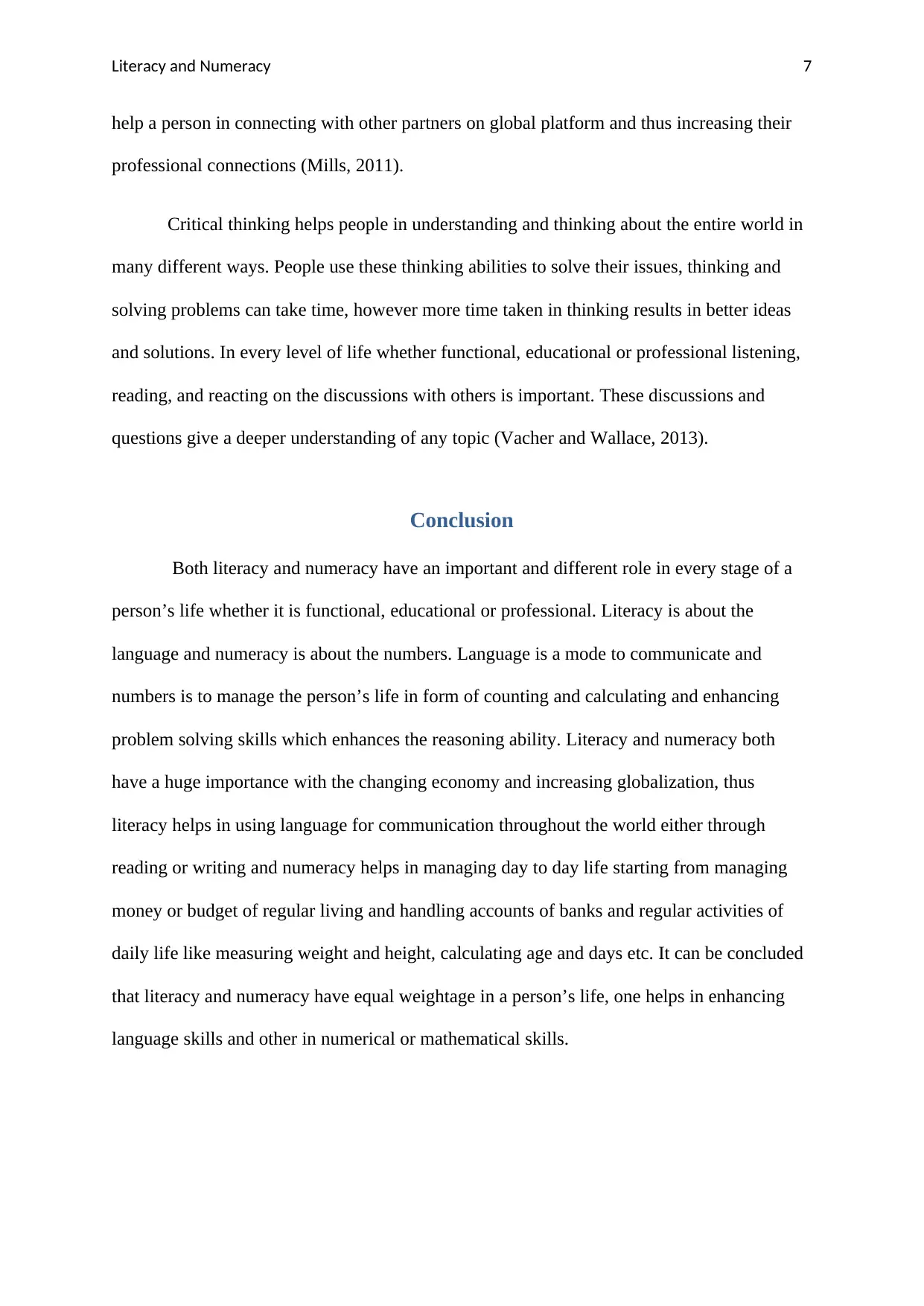
Literacy and Numeracy 7
help a person in connecting with other partners on global platform and thus increasing their
professional connections (Mills, 2011).
Critical thinking helps people in understanding and thinking about the entire world in
many different ways. People use these thinking abilities to solve their issues, thinking and
solving problems can take time, however more time taken in thinking results in better ideas
and solutions. In every level of life whether functional, educational or professional listening,
reading, and reacting on the discussions with others is important. These discussions and
questions give a deeper understanding of any topic (Vacher and Wallace, 2013).
Conclusion
Both literacy and numeracy have an important and different role in every stage of a
person’s life whether it is functional, educational or professional. Literacy is about the
language and numeracy is about the numbers. Language is a mode to communicate and
numbers is to manage the person’s life in form of counting and calculating and enhancing
problem solving skills which enhances the reasoning ability. Literacy and numeracy both
have a huge importance with the changing economy and increasing globalization, thus
literacy helps in using language for communication throughout the world either through
reading or writing and numeracy helps in managing day to day life starting from managing
money or budget of regular living and handling accounts of banks and regular activities of
daily life like measuring weight and height, calculating age and days etc. It can be concluded
that literacy and numeracy have equal weightage in a person’s life, one helps in enhancing
language skills and other in numerical or mathematical skills.
help a person in connecting with other partners on global platform and thus increasing their
professional connections (Mills, 2011).
Critical thinking helps people in understanding and thinking about the entire world in
many different ways. People use these thinking abilities to solve their issues, thinking and
solving problems can take time, however more time taken in thinking results in better ideas
and solutions. In every level of life whether functional, educational or professional listening,
reading, and reacting on the discussions with others is important. These discussions and
questions give a deeper understanding of any topic (Vacher and Wallace, 2013).
Conclusion
Both literacy and numeracy have an important and different role in every stage of a
person’s life whether it is functional, educational or professional. Literacy is about the
language and numeracy is about the numbers. Language is a mode to communicate and
numbers is to manage the person’s life in form of counting and calculating and enhancing
problem solving skills which enhances the reasoning ability. Literacy and numeracy both
have a huge importance with the changing economy and increasing globalization, thus
literacy helps in using language for communication throughout the world either through
reading or writing and numeracy helps in managing day to day life starting from managing
money or budget of regular living and handling accounts of banks and regular activities of
daily life like measuring weight and height, calculating age and days etc. It can be concluded
that literacy and numeracy have equal weightage in a person’s life, one helps in enhancing
language skills and other in numerical or mathematical skills.
Paraphrase This Document
Need a fresh take? Get an instant paraphrase of this document with our AI Paraphraser
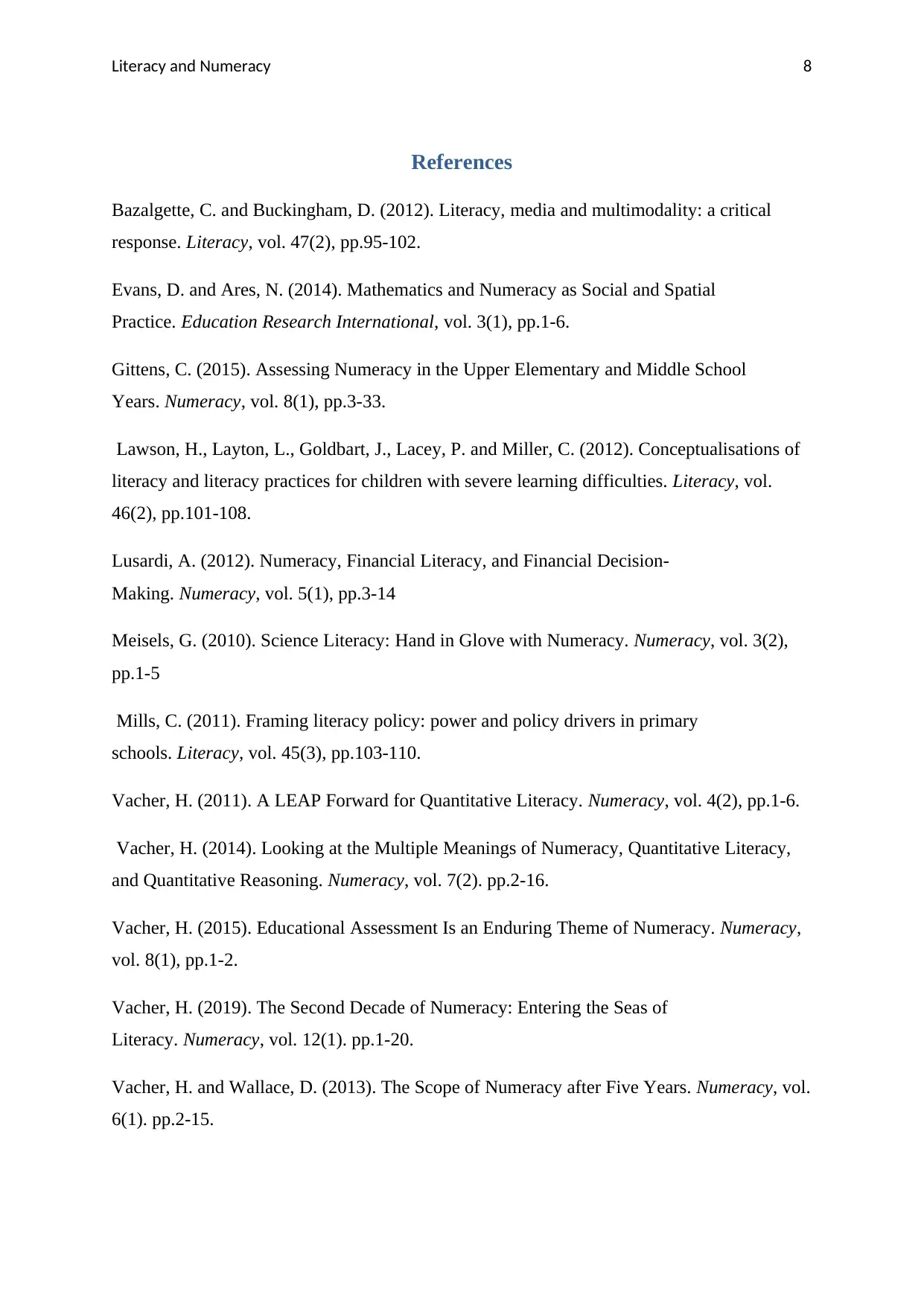
Literacy and Numeracy 8
References
Bazalgette, C. and Buckingham, D. (2012). Literacy, media and multimodality: a critical
response. Literacy, vol. 47(2), pp.95-102.
Evans, D. and Ares, N. (2014). Mathematics and Numeracy as Social and Spatial
Practice. Education Research International, vol. 3(1), pp.1-6.
Gittens, C. (2015). Assessing Numeracy in the Upper Elementary and Middle School
Years. Numeracy, vol. 8(1), pp.3-33.
Lawson, H., Layton, L., Goldbart, J., Lacey, P. and Miller, C. (2012). Conceptualisations of
literacy and literacy practices for children with severe learning difficulties. Literacy, vol.
46(2), pp.101-108.
Lusardi, A. (2012). Numeracy, Financial Literacy, and Financial Decision-
Making. Numeracy, vol. 5(1), pp.3-14
Meisels, G. (2010). Science Literacy: Hand in Glove with Numeracy. Numeracy, vol. 3(2),
pp.1-5
Mills, C. (2011). Framing literacy policy: power and policy drivers in primary
schools. Literacy, vol. 45(3), pp.103-110.
Vacher, H. (2011). A LEAP Forward for Quantitative Literacy. Numeracy, vol. 4(2), pp.1-6.
Vacher, H. (2014). Looking at the Multiple Meanings of Numeracy, Quantitative Literacy,
and Quantitative Reasoning. Numeracy, vol. 7(2). pp.2-16.
Vacher, H. (2015). Educational Assessment Is an Enduring Theme of Numeracy. Numeracy,
vol. 8(1), pp.1-2.
Vacher, H. (2019). The Second Decade of Numeracy: Entering the Seas of
Literacy. Numeracy, vol. 12(1). pp.1-20.
Vacher, H. and Wallace, D. (2013). The Scope of Numeracy after Five Years. Numeracy, vol.
6(1). pp.2-15.
References
Bazalgette, C. and Buckingham, D. (2012). Literacy, media and multimodality: a critical
response. Literacy, vol. 47(2), pp.95-102.
Evans, D. and Ares, N. (2014). Mathematics and Numeracy as Social and Spatial
Practice. Education Research International, vol. 3(1), pp.1-6.
Gittens, C. (2015). Assessing Numeracy in the Upper Elementary and Middle School
Years. Numeracy, vol. 8(1), pp.3-33.
Lawson, H., Layton, L., Goldbart, J., Lacey, P. and Miller, C. (2012). Conceptualisations of
literacy and literacy practices for children with severe learning difficulties. Literacy, vol.
46(2), pp.101-108.
Lusardi, A. (2012). Numeracy, Financial Literacy, and Financial Decision-
Making. Numeracy, vol. 5(1), pp.3-14
Meisels, G. (2010). Science Literacy: Hand in Glove with Numeracy. Numeracy, vol. 3(2),
pp.1-5
Mills, C. (2011). Framing literacy policy: power and policy drivers in primary
schools. Literacy, vol. 45(3), pp.103-110.
Vacher, H. (2011). A LEAP Forward for Quantitative Literacy. Numeracy, vol. 4(2), pp.1-6.
Vacher, H. (2014). Looking at the Multiple Meanings of Numeracy, Quantitative Literacy,
and Quantitative Reasoning. Numeracy, vol. 7(2). pp.2-16.
Vacher, H. (2015). Educational Assessment Is an Enduring Theme of Numeracy. Numeracy,
vol. 8(1), pp.1-2.
Vacher, H. (2019). The Second Decade of Numeracy: Entering the Seas of
Literacy. Numeracy, vol. 12(1). pp.1-20.
Vacher, H. and Wallace, D. (2013). The Scope of Numeracy after Five Years. Numeracy, vol.
6(1). pp.2-15.
1 out of 8
Related Documents
Your All-in-One AI-Powered Toolkit for Academic Success.
+13062052269
info@desklib.com
Available 24*7 on WhatsApp / Email
![[object Object]](/_next/static/media/star-bottom.7253800d.svg)
Unlock your academic potential
Copyright © 2020–2025 A2Z Services. All Rights Reserved. Developed and managed by ZUCOL.





